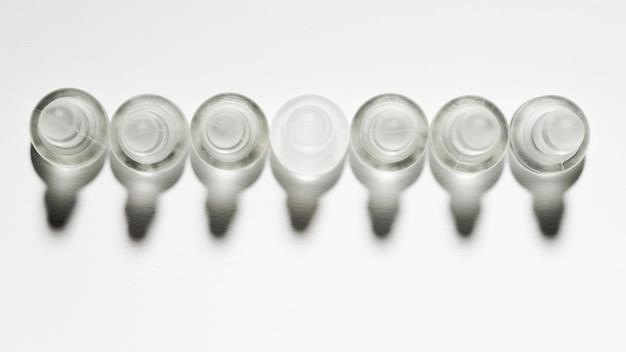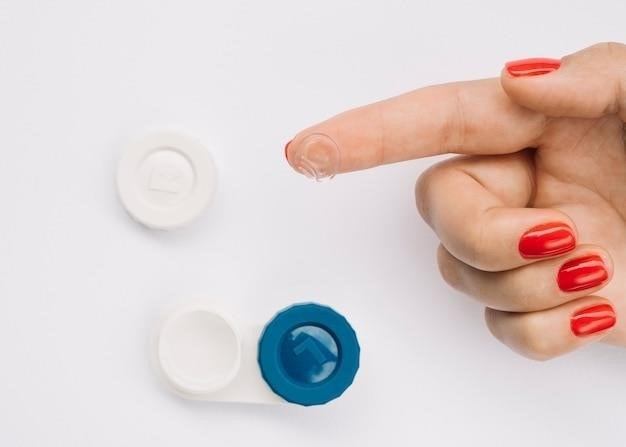dailies total 1 multifocal fitting guide

dailies total 1 multifocal fitting guide
Dailies TOTAL1 Multifocal Fitting Guide⁚ A Comprehensive Overview
This guide offers a complete approach to fitting Dailies TOTAL1 multifocal contact lenses. It covers initial assessment‚ determining dominance‚ power selection‚ add power considerations‚ utilizing manufacturer resources‚ fine-tuning‚ follow-up‚ troubleshooting‚ and achieving patient satisfaction. Success hinges on understanding the unique water gradient design and following the fitting guide precisely.
Initial Assessment and Patient History

The initial consultation for Dailies TOTAL1 multifocal fitting begins with a thorough patient history. This includes a comprehensive review of their current visual needs‚ lifestyle‚ and previous experience with contact lenses‚ including any past successes or failures. Inquire about any ocular surface disease‚ allergies‚ or sensitivities that might impact lens comfort or adaptation. Detailed information about their spectacle prescription‚ including the addition power and its effectiveness‚ is crucial. Assess the patient’s visual demands‚ including near‚ intermediate‚ and distance vision requirements. Determine their level of technological proficiency‚ especially if they will be using online resources like fitting calculators. Note their expectations and concerns regarding multifocal contact lens wear. A complete case history will streamline the fitting process and increase the likelihood of a positive outcome. Remember to discuss expectations and potential challenges associated with multifocal adaptation. Finally‚ document all relevant findings meticulously for accurate record-keeping and future reference.
Determining Ocular Dominance and Spectacle Prescription
Accurately determining ocular dominance is a critical first step in successful Dailies TOTAL1 multifocal fitting. Employ the 1.00D blur test or a similar reliable method to identify the patient’s dominant eye. This information guides the initial lens selection‚ often prioritizing the dominant eye with a specific power or lens design. Obtain a comprehensive and up-to-date spectacle prescription. This includes sphere‚ cylinder‚ axis‚ and add power. Verify the accuracy of this prescription through subjective and objective refraction‚ ensuring the values reflect the patient’s current refractive error. Pay close attention to the add power‚ as this directly impacts near vision correction with multifocal lenses. Consider the patient’s current level of satisfaction with their spectacle correction; this provides valuable insight into their visual expectations. Document the prescription details meticulously to ensure consistent communication and record-keeping throughout the fitting process. Accurate determination of dominance and a precise spectacle prescription are paramount for optimal lens selection and a successful fitting outcome.
Selecting the Appropriate Distance Power

Choosing the correct distance power is crucial for comfortable and effective Dailies TOTAL1 multifocal lens wear. Begin by calculating the spherical equivalent of the patient’s spectacle prescription. This provides a starting point for determining the distance power for each eye. However‚ this is not always the final power used‚ as individual patient responses vary. Consider the patient’s age‚ lifestyle‚ and visual demands. Younger presbyopes may tolerate a slightly lower add power‚ while older patients may need a higher add for comfortable near vision. The fitting guide should be followed precisely for recommendations‚ but it is important to exercise clinical judgment. Fine-tuning may be necessary based on the patient’s feedback. Begin with the spherical equivalent; if the patient reports blurred distance vision‚ consider small adjustments (+/- 0.25D) to optimize clarity. Always maintain open communication with the patient throughout the process. Their subjective feedback is invaluable in determining the best distance power for their individual needs and ensuring a successful fit.
Choosing Add Power⁚ Considering Patient Needs and Lens Design
Selecting the appropriate add power for Dailies TOTAL1 multifocal lenses requires careful consideration of both the patient’s specific needs and the lens’s unique design. Start by determining the patient’s near vision requirements. This is dependent on their lifestyle and occupational demands. For example‚ someone who engages in close-up work such as reading or sewing may require a higher add power than a patient with less demanding near vision needs. The Dailies TOTAL1 lens’s water gradient design influences add power selection. This technology distributes power across the lens surface differently than traditional designs‚ impacting the effective add power. Consult the manufacturer’s fitting guide for recommended starting add powers based on the patient’s age and refractive error. Remember‚ beginning with equal add powers in both eyes is generally recommended. However‚ unequal add power may be necessary for some patients based on their individual response. Always prioritize patient comfort and visual acuity. Fine-tune the add power based on the patient’s feedback‚ adjusting in small increments (+/- 0.25D) until optimal near vision is achieved without compromising distance vision.
Utilizing Manufacturer Fitting Guides and Calculators
Manufacturer-provided resources are invaluable for successful Dailies TOTAL1 multifocal fitting. Alcon’s comprehensive fitting guide offers detailed instructions‚ parameters‚ and algorithms crucial for lens selection. This guide provides starting points for distance and add power based on the patient’s spectacle prescription and individual needs. It also details the lens’s unique water gradient design and how it impacts power distribution. Understanding this design is key to making informed decisions during the fitting process. Online calculators are another useful tool. These often streamline the fitting process by suggesting appropriate lens parameters based on patient data. However‚ these calculators should be used as a guide‚ not a replacement for clinical judgment. Always cross-reference the calculator’s recommendations with the manufacturer’s detailed fitting guide. The fitting guide often includes troubleshooting tips for common issues. This information can be invaluable for resolving difficulties‚ such as blurred vision at specific distances or discomfort. By fully utilizing both the fitting guide and any available calculators‚ practitioners can significantly improve their multifocal fitting success rates and patient satisfaction.
Fine-tuning the Fit⁚ Addressing Comfort and Visual Acuity
Once an initial lens is fitted‚ fine-tuning is crucial for optimal comfort and visual acuity with Dailies TOTAL1 multifocals. Begin by assessing the patient’s subjective experience. Inquire about any discomfort‚ including dryness‚ foreign body sensation‚ or blurry vision at various distances. Observe the lens centration and movement on the eye. Poor centration can significantly affect vision quality‚ leading to blurred or distorted images. Assess the lens movement post-blink. Smooth return to center indicates proper fit; excessive movement or sluggish return suggests the need for adjustment. If discomfort arises‚ explore potential causes. Dryness might necessitate artificial tear use or a change in lens material. Blurred vision may require adjustments to the add power‚ distance correction‚ or even a switch to a different lens design. Remember‚ the goal is to balance clear vision at all distances with comfort. Minor adjustments to power‚ often in 0.25D increments‚ can greatly impact the patient’s experience. Careful observation‚ coupled with open communication‚ allows practitioners to refine the fit‚ leading to a successful outcome. Document all adjustments made‚ and encourage regular follow-up visits to monitor progress and address any emerging concerns. The iterative process of assessment‚ adjustment‚ and reassessment is key to achieving the best possible result.
Monitoring Patient Progress and Follow-up Care
Post-fitting‚ scheduled follow-up appointments are vital for successful Dailies TOTAL1 multifocal lens wear. The initial follow-up‚ ideally within one week‚ allows assessment of adaptation and addresses any immediate concerns. During this visit‚ evaluate visual acuity at distance and near‚ and reassess lens centration and comfort. Patients should describe their experience‚ noting any improvements or persistent issues. Common early concerns include blurry vision‚ particularly at intermediate distances‚ and occasional dryness or discomfort. These can often be addressed with minor adjustments or supportive measures like artificial tears. Subsequent follow-up visits‚ spaced appropriately based on the patient’s adaptation‚ allow for ongoing monitoring and fine-tuning. Regular assessment ensures the lenses continue to provide optimal vision and comfort. Throughout the process‚ emphasize the importance of patient compliance with lens care instructions and the need to report any changes in vision or comfort. Open communication fosters a positive experience and aids in identifying and resolving potential problems promptly. Proactive monitoring helps ensure long-term success with Dailies TOTAL1 multifocal lenses‚ maintaining patient satisfaction and reinforcing the value of regular eye care;
Troubleshooting Common Issues and Adjustments
While Dailies TOTAL1 multifocal lenses aim for seamless vision‚ some challenges may arise. Blurred distance vision might necessitate a slight reduction in the distance power‚ while difficulty with near vision could indicate the need for a higher add power. If the patient experiences discomfort or dryness‚ consider the possibility of inadequate lens fit or insufficient tear production. In such cases‚ lubricating drops or a change in lens handling techniques might help. Decentration can impact visual quality; ensure proper lens placement and centration. If the patient reports glare or halos‚ especially at night‚ consider adjusting the add power or evaluating for other underlying conditions. Remember that adaptation time varies. Some patients might require more time to fully adjust than others. Persistent issues despite adjustments warrant further investigation. Examine the ocular surface health‚ checking for signs of inflammation or infection‚ which could compromise lens performance. Careful observation‚ coupled with clear communication with the patient‚ is key. Document all adjustments made and patient feedback‚ allowing for a comprehensive record of the fitting process and any necessary refinements to optimize their visual experience with the Dailies TOTAL1 multifocal lenses.
Successful Multifocal Fitting⁚ Achieving Patient Satisfaction
A successful Dailies TOTAL1 multifocal fitting translates to a satisfied patient. This involves not only achieving optimal visual acuity at both near and distance‚ but also ensuring comfort and ease of wear. Thorough communication throughout the fitting process is paramount; Explain the technology behind the lenses‚ manage patient expectations regarding adaptation time‚ and address any concerns proactively. Post-fitting‚ schedule regular follow-up appointments to monitor comfort and visual performance. Address any residual issues promptly‚ making necessary adjustments to ensure the best possible outcome. Positive patient feedback is a key indicator of success. Encourage patients to share their experiences‚ both positive and negative‚ to aid in fine-tuning the fitting process. Remember that a successful fit extends beyond just visual acuity; it’s about creating a positive and empowering experience for the patient‚ fostering trust and loyalty. By combining precise fitting techniques with excellent patient care‚ you maximize the likelihood of achieving lasting patient satisfaction and build a reputation as a skilled contact lens practitioner. This approach ultimately translates to referrals and a thriving practice‚ demonstrating the value of meticulous attention to detail in multifocal contact lens fitting.